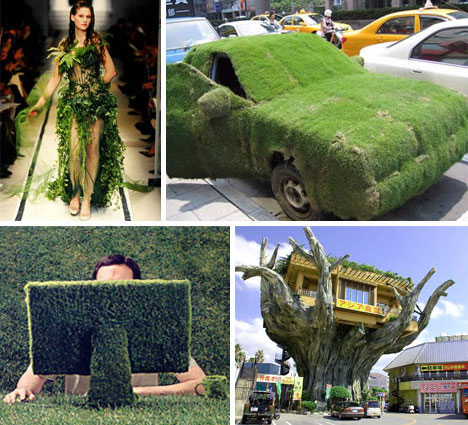
The design of a great eco-friendly product takes more than meets the eye... beyond the environmental and social considerations, a designer has to create something that people want and like -- what good is an organic, fair trade gizmo or accessory if no one cares to use it? A great product is one that not only serves its purpose well, but encourages green behavior with its use (and looks darn good doing it).
I got a taste of the world of a green designer when I took a workshop from the creative firm Ideo Design. The session was called “Designing for Green Behaviors” and it was packed full of people eager to design the way to a more sustainable society. We started off the session by getting into groups of three or four and picking an object on our person to redesign to be more sustainable. My group picked a plastic bracelet with sequins inside. The plastic was already made out of some sort of scrap roofing material, but when thinking about the full circle life of the bracelet, we saw it wearing and tearing over the years and being put into a landfill where it would inevitably be leeching all sorts of plasticy grossness. The lady to my left suggested the use of the same compostable potato starch material that was easily disguised as clear plastic for disposable cups we'd been sipping juice out of. Compostable jewlery? Sounds pretty good to me.
In addressing the same plastic waste problem for the silver sequins floating inside, I remembered back to Doug Wentzel showing me the wondrous world of jewel weed, a common plant in Pennsylvania with beautiful orange flowers that attract bees and butterflies. He showed me that you can break the stem and rub the fluid inside on your poison ivy to make it stop itching and dry up. You can then take the stem and hold it under the water of a passing stream and the leaves will look like beautiful shiny silver. So, I thought we could plant some jewel weed here and there, beautifying and attracting pollinators to the area in the process, and then take a hole punch to a few of the leaves on different plants to make naturally decomposing sequins to float in our potato starch bracelet. For being the only non-engineer of the group, I was quite proud of my idea.
The folks at Ideo went on to explain their process they use when designing for their clients and, more specifically, the people who will be likely to use their products or services. Their process centered on the behaviors and relationship that their designs create, emphasizing the creation of an experience.
We were then shown a slide show of about 15 photos from a stranger’s day. As a group, we tried to piece together a profile of the person: their name, age, occupation, life stage, bad habits, favorite Sunday activity, last book read, dream vacation, and so on. A few groups shared their informed guess and were surprisingly close to the profile of the actual man.
We then redesigned the bracelet for this man, while being sure to keeping the green in green re-design. Our group decided that we could engrave the bracelet with some sort of quote he may like, or maybe with some sort of anniversary or birthday date or well wishing so he could give it to his wife. If it were a gift, it would need a box most likely, so we decided the box would be made of decomposable paper with jewel weed seeds pressed in as I had seen on a wedding invitation. Inside the box are written instructions on planting the box and sharing the uses of jewel weed. Maybe a dried jewel weed flower is pressed into the top for the finishing touch. (Any other suggestions to make it better, Readers??)
If we had more time, we could have gone for another hour tweaking our bracelet into the perfect specimen of green design. It really made me realize I could be approaching many of my design dilemmas in my life this way, constantly improving my living space, my transportation situation, my wardrobe :), my general approach to life! One thing I would have to perfect is my desire to be able to recycle things by composting, reusing, and reinventing, next to my desire to have a well made, quality product (ok, I'm talking about clothes here) that will last me a lifetime, so we don't even need to spend the energy involved with recycling in the first place. This is what the Slow Fashion movement is all about, but that's a whole other compost bin of worms.

1 comment:
I'm rooted to these designs =)
Post a Comment